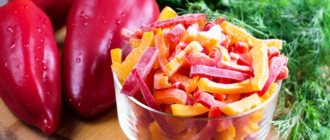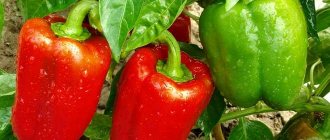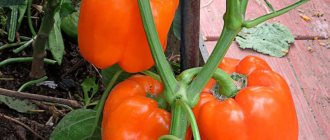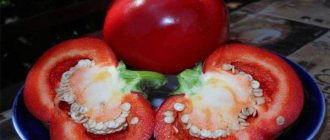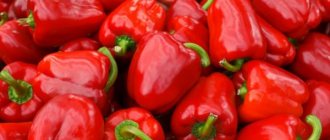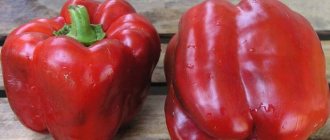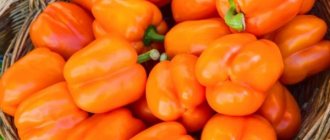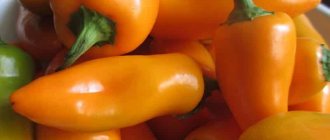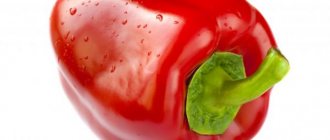Vegetable growing » Pepper
0
1344
Article rating
Kira Stoletova
The time it takes for peppers to germinate from the moment the seeds are planted depends on many factors. The timing of sowing, the condition of the soil and the seed itself also play an important role. Let's consider how many days it takes for pepper to sprout after sowing.
How many days does it take for a pepper to germinate?
How many days does it take for sweet pepper seeds to sprout?
Sweet (or, as it is sometimes called, “bell”) pepper is considered one of the slowest growing vegetable crops.
The grains take a long time to hatch, so you have to wait longer for shoots than for the same tomatoes.
In the most favorable conditions (at a temperature not lower than 25 degrees), pepper seeds germinate in 5 to 10 days.
ON A NOTE. At low temperatures (23 - 25 degrees), the emergence of seedlings can be expected within 3 weeks.
Pepper seedlings 2021 from seeds: how to grow correctly?
Now there are 2 varieties of this vegetable: spicy and sweet.
Pepper was brought to Europe from South America. Now there are 2 varieties of this vegetable: spicy and sweet. Sweet pepper in our country is called Bulgarian, since it came to Russia from there. This article describes step by step the process of growing sweet pepper seedlings at home.
Requirements for growing conditions for peppers
To plant and grow good sweet pepper seedlings in an apartment, the following conditions must be met:
The soil. Pepper loves rich, fertile soils with a neutral reaction. The soil must be warm; plants do not develop in cold soil.
Light. Peppers are less demanding of light than tomatoes and eggplants. During the seedling period, it requires 12-15 hours of daylight for growth, therefore, it needs less additional light than other crops.
Warm . Pepper seedlings' heat requirements are second only to eggplants. For plants, you need to maintain a temperature of +26-28°C during the day and +20-24°C at night. If the temperature on the windowsill with seedlings is below 17-18°C, the growth of pepper stops. For hybrids, the temperature should be 3°C higher than for varieties.
Moisture. The culture loves moist soil, but does not tolerate waterlogging. Pepper needs frequent but very moderate watering with warm, settled water.
Variety selection
The crop has a very long growing season. In sweet (bell) pepper it is longer than in hot pepper:
- early ripening varieties begin to bear fruit 110-120 days after emergence;
- mid-season after 125-135 days;
- Late-ripening varieties begin bearing fruit 140 days after germination.
Hot peppers begin fruiting a little earlier:
- early varieties - after 105-110 days;
- mid-season - 115-125 days;
- late 130 days.
Late varieties are suitable for cultivation only in the south of Russia: in the Crimea, in the Caucasus. Their fruits are large, thick-walled and require at least 150 days to ripen.
In the middle zone and to the north it is better to grow early varieties. Even mid-ripening sweet peppers may not produce a harvest (3-5 fruits do not count) due to weather conditions. Hot peppers can be grown both early and mid-ripening, since they are more resistant to low temperatures. It is necessary to plant hybrids in the middle zone, even early ripening ones, very carefully, since they require higher temperatures during the fruiting season than occurs in the summer in these areas.
But in the Central Black Earth region and southern Siberia, mid-season varieties with proper care will give a good harvest. Even tall varieties and hybrids can be planted and grown here if the summer in the region is long and warm.
Timing for sowing seeds for seedlings
Some people start growing seedlings in January, but it should be borne in mind that in the cotyledon phase, peppers require sun for further growth. If the weather is cloudy, the plants do not begin to grow for a very long time, despite the lighting. Therefore, the timing of planting pepper seedlings is chosen so that after germination there are at least a few days of sunshine.
In greenhouses, seedlings in the middle zone are planted at the age of 90-95 days in early June, when the threat of frost has passed. To this time, add another 10 days from sowing to germination and get a sowing date of February 5-10.
In the southern regions, late-ripening varieties and hybrids can be planted at the beginning of February; mid- and early-ripening varieties are sown at the end of the month. Seedlings can be planted in open ground at the age of 65-75 days. Summer here is longer and even with late planting, varieties and hybrids will produce a harvest.
If you plant seedlings too early (in January), this will lead to slow development of seedlings. Pepper grows slowly and by the time of planting in the ground the seedlings will not have reached the required stage of development, and this will lead to a decrease in yield.
Soil for growing seedlings
The crop requires fertile soil. Neither garden soil nor purchased peat are suitable for planting pepper seedlings.
Peat absorbs all moisture very quickly and completely, and plants planted in it suffer from dry soil. Garden soil in the Non-Black Earth regions has an acidic reaction and pepper, at best, will not grow, at worst, it will not sprout at all.
Another option: leaf soil, sand, peat (2:1:1). Leaf soil can be taken from any deciduous trees, except chestnut and oaks. The leaf litter of these species contains too many tannins, which has an adverse effect on the seedlings. There is no need to take soil under coniferous trees, since it is too acidic; ash must be added to neutralize the acidity.
In self-prepared mixtures, be sure to add 2 tablespoons of potassium and 1 tablespoon of phosphorus. spoon onto a bucket of mixture. There is no need to add nitrogen to the soil mixture, otherwise the seedlings will become very stretchy.
But if peat predominates in the soil mixture, then it must be diluted. Before buying, they look at the composition of the soil and buy soils from different manufacturers. As a rule, they contain different amounts of peat and are mixed to obtain soil for seedlings. If it is not possible to purchase several types of soil, then add soil from indoor flowers and ash to the existing one. This is not the best option, but if there are no other soil mixtures, it will also work.
What is the best place to grow peppers?
You cannot plant peppers in peat pots and peat blocks. The seedlings do not develop well in them.
Firstly, peat gives a strong acidic reaction, which is unfavorable for the crop, and secondly, it is poorly wetted and quickly absorbs irrigation water, only a small amount reaches the roots.
In such containers, seedlings suffer greatly from lack of moisture. In addition, after planting in a greenhouse, the roots of the crop find it very difficult to grow through the peat wall, which greatly retards growth.
Preparing the soil mixture for sowing seeds
The earth can be frozen, steamed, calcined in the oven, or treated with special solutions.
Calcination and steaming of the soil must be carried out before adding all fertilizers to it. Otherwise, at high temperatures, decomposition of minerals occurs. If the soil is purchased, then it cannot be steamed or calcined. They are either frozen or disinfected.
To disinfect the soil, it is spilled with a burgundy solution of potassium permanganate dissolved in hot water.
You can treat the soil with biological products: Fitosporin, Alirin, Trichodermin, Planriz. But trichoderma (a strain of saprophyte fungus) is usually added to purchased soils, so they are not treated with other biological products. Otherwise, a war will arise between different types of microflora, the beneficial flora will mutually destroy each other and the growth of pathogens will begin. Before spilling the soil with a biological product, you need to read the composition of the soil mixture.
After any treatment, the soil ready for planting is covered with film and placed in a warm place for 3 days so that the soil warms up.
Preparing pepper seeds for sowing
First of all, pepper seeds are treated against diseases. The drug Maxim is usually used; it is the most effective. For dressing, you can soak the seed material in a saturated pink solution of potassium permanganate for 20 minutes. A good effect is obtained by keeping the seeds in a thermos with water heated to 53-55°C for 20-25 minutes. If the seeds are pre-treated, then there is no need to treat them.
The seeds of the crop are difficult to germinate, therefore, to increase germination, they are treated with growth stimulants. Usually Silk (Novosil), Energen, Zircon, Epin are used. Aloe juice is often used as a stimulant, but it is not very suitable for peppers, since the seeds do not swell easily when soaked. They need to be soaked for at least 3-5 days, but aloe juice has very strong biological activity and will simply burn the seeds over such a long period.
It is usually recommended to soak the seeds in a small amount of water, otherwise they will lack oxygen and suffocate. This is true for pumpkins and, to some extent, legumes, but not for peppers.
Due to the difficulty of swelling and germination, the seeds are soaked so that they are completely covered with water. By the time intensive respiration and germination begin, part of the water will evaporate and the seeds will have enough oxygen and moisture.
The soaked seeds are placed on a hot radiator. Concerns that the peppers are too hot there are unfounded. To germinate, it requires a temperature of 28-30°C for varieties and 32-34°C for hybrids. At this temperature, the pepper will hatch within 5-6 days. But usually the temperature in the apartment is lower, so the seeds germinate, at best, after 10 days.
If the seeds are fresh, but do not hatch, it means they are too cold and need to raise the temperature. Then the seeds are placed in a thermos, filled with a small amount of water at room temperature and placed on the radiator. As a rule, seedlings appear after 7-10 days.
Terms and conditions for germination of pepper seeds
The rate of seed germination directly depends on the soil temperature, so the box with the seeds is placed on a radiator. The most favorable soil temperature for germination is 30-32°C; peppers sprout within 6-7 days.
If the ground is warmed up to 25-27°C, then the seeds will germinate in 2 weeks, and if the ground is cold (22-23°), then seedlings will appear in 20-22 days.
If the ground temperature in the seedling box is below 22°C, the pepper may not sprout at all. There will be no seedlings even if the ground temperature is more than 36°C; at this temperature the embryo dies.
How to grow strong seedlings at home
Immediately after the first shoots appear, the seedlings are placed on the windowsill, without waiting for all the seeds to germinate. If the seedlings are kept under the film for a long time, they become very elongated. The remaining seeds will sprout within a week and quickly overtake the first group. Seeds that germinate later should be removed, since they will obviously be weaker than the rest of the seedlings.
Lighting
To grow pepper seedlings strong and healthy, they must be provided with good lighting. For the first true leaves to appear, pepper seedlings need sun during the cotyledon period. Therefore, if it is a sunny day, the seedlings are placed in the sunniest place in the house. In the absence of light, the pepper will have to be illuminated a lot.
In cloudy weather, additional lighting of pepper is carried out even during the day. In the absence of sun, additional lighting should be at least 10 hours, preferably 12-13 hours, the seedlings are placed directly under the llama. The pepper should “seem” to be illuminated by the sun, only then will real leaves begin to grow.
If the days are sunny, then the seedlings are illuminated for 5-6 hours. In case of partly cloudy weather, the pepper is additionally illuminated for 8 hours depending on the weather.
Pepper is a short-day plant and after the first true leaves appear, it needs only a little additional light. In February it is no more than 12 hours a day, in March - 10 hours at the beginning, 4-5 hours at the end of the month, in April the plants are not illuminated additionally.
With a lack of light, the growth of seedlings slows down, but they do not stretch as much as tomatoes and eggplants.
Warm
- Immediately after the first shoots appear, the peppers are placed on the sunny and warmest windowsill. The temperature is reduced to 18-20°C even for hybrids.
- After 3-4 days, the temperature is increased to 20-25°C, while the soil temperature should not be lower than 22-24°C, otherwise the development of the root system of seedlings will slow down.
- The seedlings will withstand a drop in air temperature to 17-18°C, but if the ground cools to the same temperature, the roots will stop functioning.
- Plants should not be placed against the glass itself or left in a draft. Seedlings can be taken out to the balcony if the temperature there is not lower than 20°C; if lower, it will only harm the crop.
Watering
You need to water the seedlings only with warm water with a temperature of at least 20°C. Cold water is poorly absorbed and, despite abundant watering, seedlings may suffer from lack of moisture. In addition, it cools the soil, which is very unfavorable for peppers, especially for hybrids.
The water must be settled. When watering with unsettled water, a white bacterial-lime deposit appears on the surface of the ground, which negatively affects the growth of the crop in the initial period of development.
Top dressing
At an early age, plants are not fertilized due to the fact that the root system develops slowly. If seedlings in an apartment do not begin to grow for a long time (more than 25 days), then they can be fed with preparations for indoor flowers containing reduced doses of nitrogen or without it at all.
Nitrogen causes the stem to strongly elongate, which is not typical for pepper, and the seedlings become thin and weak. The main thing in the early stage of development is the sun; if it is there, then the crop does not need feeding.
Picking pepper seedlings
Peppers are picked after 4-5 true leaves appear. At an early age, the crop tolerates transplantation very poorly; the above-ground part grows faster than the roots. When replanting, no matter how carefully it is carried out, some of the sucking roots still break off and the plant cannot quickly restore them. Therefore, with early picking, a large number of plants die.
At an older age, the roots of the seedlings are sufficiently formed and during transplantation, even if a certain number of sucking roots are lost, this is not so critical for the seedlings.
The pot in which the pepper will be planted is filled 1/3 with soil. The seedlings are watered abundantly and the plants are dug out from the seedling box. It is advisable that the roots are not exposed, but with a lump of earth.
The dug up plant is placed in a planting pot, the roots are carefully straightened, it is unacceptable for them to bend upward or curl, and they are covered with earth. The soil around the plant is compacted and watered with warm water. When planting, plants are held by the leaves and not by the stem, which can easily break.
If you plant pepper seedlings in small pots, then in them the roots will entwine the earthen ball in a circle and after planting in open ground they will not grow in width and depth for a long time.
When picking, the pepper is not buried, since at this age it practically does not form adventitious roots. They plant it at the same depth at which it grew. When planting in depth, part of the stem that is underground may rot.
The harvested seedlings are placed in a shaded place for several days, but if the weather is cloudy, they can also be placed on a windowsill. Plants are not given additional light for 3-5 days.
Caring for seedlings after picking
After picking in the middle zone and to the north, the seedlings are kept in the house for another 2-2.5 months. In the south this period is shorter.
In the first few days, do frequent but very small watering. When the seedlings get stronger and begin to grow again, reduce watering to 2-3 times a week, making sure that the soil does not dry out.
The temperature is maintained at least 20-22°C. After the heating is turned off in the apartments, the pepper is placed on the warmest window, and at night, when the temperature in the room is 15-16 ° C, the heater is turned on. If plants don't get enough heat, they stop growing. If possible, on warm days the crop is taken to a greenhouse or to a balcony if the temperature there is not lower than 22°C.
Feeding seedlings
At an early age, plants are not fed. But after picking and before planting seedlings in the ground, peppers need regular feeding.
5-7 days after picking, fertilizing is done. Pepper is a potassium lover, so the fertilizer should contain high doses of this element and a moderate nitrogen content. Nitrogen inevitably causes the seedlings to stretch out, which has a bad effect on their further development. Fertilizers usually used are Zdraven, Uniflor-Buton, Agricola for flowering plants, and potassium monophosphate.
Feeding is done weekly until the plants are planted in the ground. When feeding, alternate preparations containing nitrogen and nitrogen-free fertilizers.
Hardening
They begin to harden seedlings 3 weeks before planting in a permanent place and only if the outside temperature is not lower than 18-19°C. On warm days, the plants are taken out to the open balcony and left there for the whole day, putting them in the room only at night. If possible, the seedlings are placed in a greenhouse.
Planting seedlings in open ground can be done when the soil warms up to 16-18°C (for hybrids 20°C).
Reasons for failure
- Pepper does not sprout well. Air and ground temperatures are too low. When planting peppers in cold soil, they may not sprout at all. If a small number of seeds have sprouted, but the rest do not hatch, then the seedling boxes are placed on a radiator so that the earth warms up. Hybrids need a higher temperature for germination and, if it is not possible to maintain it at the required level, then it is better to abandon planting hybrids and grow exclusively varieties.
- The seedlings do not develop. Plants grow at low soil and air temperatures. It is necessary to additionally heat the room, and place the seedling boxes on the radiator.
- The seedlings do not grow; after the cotyledon leaves appear, true leaves do not form. Sowing pepper seeds for seedlings too early (in January). Pepper needs sun to grow, and if the days are cloudy, then it needs to be illuminated for at least 10 hours a day, and in the case of early sowing - 12-13 hours.
- Pulling seedlings. Excessive doses of nitrogen in fertilizing. It is necessary to switch to nitrogen-free fertilizers. Peppers, unlike tomatoes and eggplants, practically do not stretch in low light, unless they grow at dusk.
- Blackleg. A fungal disease usually affects peppers at an early stage of development (2-3 true leaves), although it can appear later. The stem near the soil turns black and dries out, the plant falls and dies. It is spreading rapidly. Once blackleg is detected, diseased plants are removed immediately. The soil is shed with fungicides (Fitosporin, Alirin) or a pink solution of potassium permanganate. If the seedlings are large enough, then it is better to pick them up and then grow them in cups.
- Late blight. Quite often it affects pepper seedlings. Brown spots appear on the leaves and stem, and the tissue around them turns light green. It can appear at any age, even at the cotyledon leaf stage. It is especially pronounced at low air temperatures (below 19°C) and high humidity. At the first signs, diseased leaves are removed and the seedlings are sprayed with Previkur, Consento or HOM.
Growing good pepper seedlings at home is not at all easy. The most important thing for seedlings is warmth and sun, only then will they be strong and healthy.
Source: Dacha Plot
When do pepper seeds germinate when planted as seedlings at home?
Growing pepper seedlings at home is good because you can regulate the temperature during seed germination.
In addition, sowing can be done in loose and nutritious soil, in which it will be easier for seedlings to break through to the surface.
At a temperature of 25 degrees, the pepper will sprout after a week.
At temperatures from 23 to 25 degrees, the sprouts will hatch on about 15 days.
Are pepper seedlings growing poorly? What to do?
The seeds hatched and began to grow, but something went wrong, the growth of the seedlings slowed down, the green color loses its intensity or the plant dies altogether.
Unfortunately, this also happens. The reason lies in mistakes made when caring for young plants.
Why pepper seedlings do not develop:
- Irregularities in the irrigation regime . The root system of pepper does not tolerate even a hint of drying out. Overmoistening of the soil threatens with another danger - blackleg, a disease to which almost any seedlings of vegetable crops and flowers are susceptible. The diseased plant will die.
- Insufficient light intensity can cause seedlings to stretch out. And, if the weather is gloomy outside and the sun does not indulge in its appearance, a phytolamp will come to the aid of the gardener, which will allow him to avoid a shortage of lighting.
- Incorrect plant nutrition . The situation can be corrected by feeding with potassium humate or Agricola-Forward, diluted in water according to the instructions.
By following all the simple rules for planting pepper seeds and caring for young plants, you can get excellent seedlings and reap a good harvest in due time!
REFERENCE! Learn about different methods of growing peppers: in peat pots or tablets, in open ground and even on toilet paper. Learn the tricky method of snail planting and what diseases and pests can attack your seedlings?
When do peppers sprout in open ground?
If you live in one of the southern regions and you have a greenhouse, then theoretically you can sow peppers without seedlings, directly into the ground.
But you should know that seeds sown in this way do not germinate quickly. The fact is that the temperature outside changes. It's warm during the day, but it gets cooler at night.
Because of this, the period of emergence of sprouts increases. In addition, germination is reduced.
With a successful combination of circumstances, in open ground, pepper sprouts 15-20 days after planting.
Pre-planting preparation and landing
Pepper seeds are sown in prepared soil mixture, which should be light and not acidified. You can add a small amount of ash to it. Pepper seedlings endure picking hard and painfully . Damage to the root system, which inevitably occurs during picking, slows down the growth of the plant for 10-20 days, which will subsequently prevent an early harvest.
Planting in cups or small containers in which the seedlings will remain before planting in the ground can solve this problem. Of these, it will be easy to replant the plant using the transshipment method.
Before sowing, the seeds can be soaked for 6-7 hours in a pink solution of potassium permanganate, better known as potassium permanganate. This will make future plants more resistant to diseases.
After this, you need to leave the seeds in a damp, but not wet, napkin until they hatch. Usually this period does not exceed 2-3 days. This will allow you to reject spoiled and weak seeds. Read more about preparing seeds before planting.
Before planting, the soil must be thoroughly watered; it is very convenient to do this with a spray bottle or a medical bulb. Seeds are planted in the ground to a depth of 1.5-2 cm. After planting, the container or cups with future seedlings must be covered with film to create a greenhouse effect and placed in a warm place for germination.
What determines seed germination?
It is impossible to name any one reason that affects the germination of pepper seedlings.
Several factors influence to varying degrees. Let's list the main ones.
Temperature
Air and soil temperatures are the most important factors in the rate of grain emergence.
At temperatures below 20 degrees, the chance of sprouts appearing is minimal. The optimal value is not lower than +25 (ideally +27).
The soil should be no colder than +20, ideally +28.
ON A NOTE. If the seedlings are on a windowsill, place a piece of foam under them to create a protective layer from the cold.
Lighting
UV light is another factor that affects how quickly pepper seeds germinate. At the germination stage, too much lighting is not needed to prevent lightening of the roots, but seedlings cannot be kept in twilight.
Soil and air humidity
The soil for seedlings should be moist, but do not create a swamp in the container. The seed needs water to wake up, but excess liquid leads to rotting. Therefore, before the seeds appear, regularly moisten the soil with water from a spray bottle and do not allow it to dry out.
Planting depth
It is necessary to bury the seeds no more than 2 cm. But there is no need to sow close to the surface. The substrate is needed, among other things, to help the seed get rid of its outer shell.
Soil quality
The substrate when growing seedlings should be light and loose. These qualities will ensure access of air into the thickness of the earth.
A substrate that is too dense will not allow the sprout to sprout. It simply doesn't have enough energy to germinate.
Seed quality
The younger the seeds, the faster they will sprout. Sick specimens germinate poorly.
Pre-sowing preparation also affects germination. Those grains that have passed through it germinate faster.
How many years do seeds remain viable - shelf life
The shelf life of pepper seeds is 3 years. This time must be counted from the moment the grains are collected. When purchasing ready-made planting material, this information can be found on the packaging.
Important! If you collect it yourself, you don’t have to remove the hot pepper seeds from the pods. They should be hung in a dry place and pulled out in the spring before planting.
It is recommended to store planting material in a closed container that allows air to pass through. In this case, chemical and mechanical influences are prohibited. High humidity and exposure to direct sunlight deteriorate the quality of seeds.
Which varieties germinate later and which ones earlier?
The timing of the appearance of the first shoots also depends on the variety.
As you know, early ripening varieties have a faster growing season. This is true at all stages, including seed germination.
Late-ripening varieties germinate later.
Therefore, before sowing, study the information on the packet of seeds to roughly guide you when you need to wait for sprouts to appear.
ON A NOTE. It is best to sow identical seeds into one planting container, so that it does not happen that some of them sprouted and others did not.
How to speed up the germination of pepper seeds: two effective ways
Soaking in various growth stimulants from the store immediately comes to mind: Epine, Energen, Zircon, HB-101, etc. I sometimes use them: I soak them, then germinate them. But I didn’t see any results. Both with and without them, peppers germinate in the same number of days.
The seeds sprouted without any stimulant
But there are two ways that speed up the appearance of sprouts by 1-2 days:
- Soaking in aloe juice: can be whole or diluted 1:1 with water. I don't have enough juice, so I'm diluting it
